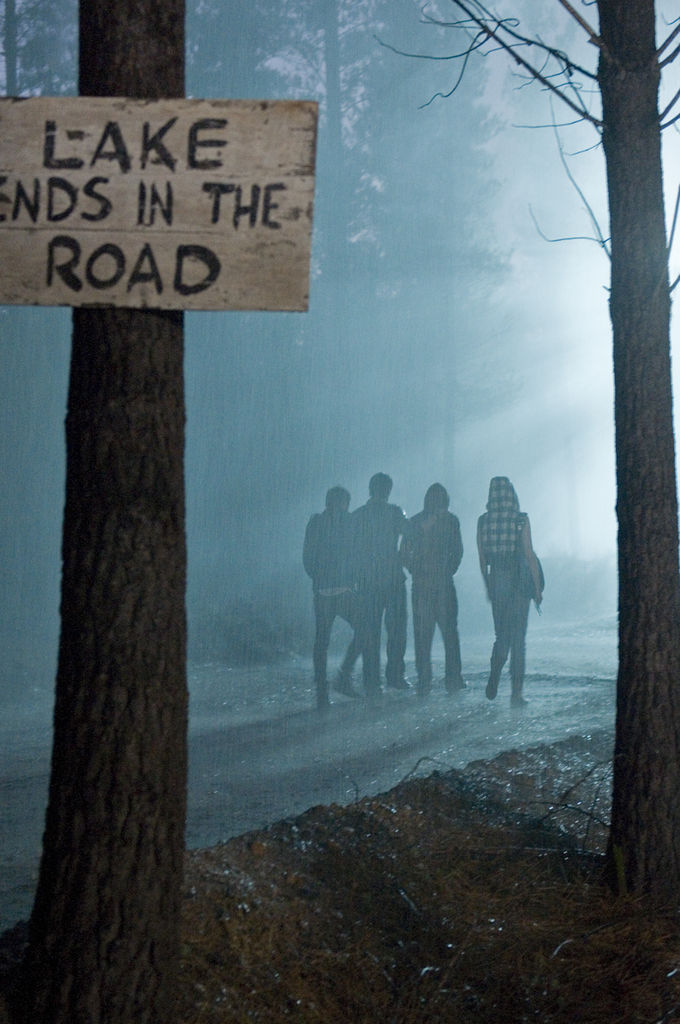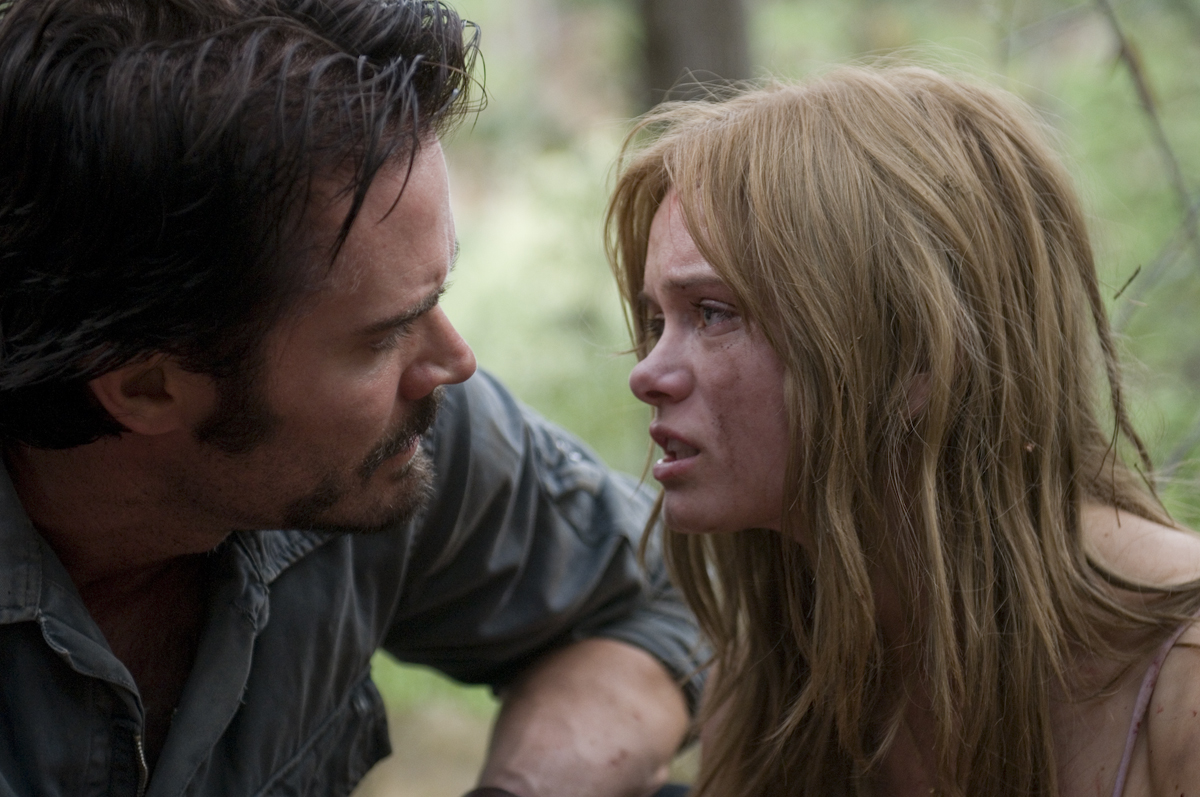
I never really expected the remake of Wes Craven’s 1972 debut feature LAST HOUSE ON THE LEFT (itself a retelling of Bergman’s 1960 THE VIRGIN SPRING) to be successful as a remake. I did, however, expect it to be at least mildly successful as a horror film, and to some extent, it is. The cast is rather good, the photography often surprises with its beauty and subtlety, and I imagine it will be quite suspenseful for audiences who haven’t seen the original. I’m guessing that will be about 90% of the people who will be seeing it in theatres.
Craven’s feature was so reviled by critics and audiences alike that he essentially disowned it (he gave away his entire collection of reels including all outtakes and footage to fan and scribe David Szulkin, who later wrote a book , nay, an obsessive monograph, about it), and the film went more or less underground for years. Having an opportunity to see an “uncut” version at the Harvard Film Archive some years ago (where Szulkin was on hand to answer questions), after having last seen it grainy and edited beyond comprehension on VHS, I was reminded of this film’s power and daring content. It certainly must be said that Horror Cinema As We Know It Today would never have existed without LAST HOUSE ON THE LEFT and the vision Craven manifested in this oft-misunderstood and much-hated film.
Wes Craven and Sean S. Cunningham, who was a producer in 1972, are credited as producers this time around, so one can assume they signed off on the new version. Greek director Dennis Iliadis helms, and the screenplay is co-adapted by Adam Alleca (a former student of mine at Emerson College) and Carl Ellsworth (DISTURBIA). The original plot is relatively intact, although the body count is somewhat smaller this time around. In the remake, Krug (DEADWOOD’s Garret Dillhunt; David Hess played Krug and composed the original songs for the 1972 version) is an escaped convict who meets up with his pals Francis (BREAKING BAD’s Aaron Paul; Fred Lincoln played “Weasel” in 1972) and Sadie (Riki Lindhome; Jeramie Rain, aka Mrs. Richard Dreyfuss, in 1972), and his son Justin (the excellent Spencer Treat Clark; Marc Sheffler was “Junior” in 1972).
In Craven’s version, Krug, Weasel and Sadie are all escaped convicts; the two men are sharing Sadie and decide they need some additional women (Sadie also hints she would like a girl to play with). Krug convinces his junkie son to procure some young female victims by promising him heroin. So Junior finds Mari Collingwood (Sandra Cassell) and Phyllis Stone (Lucy Grantham), strolling the streets in Manhattan before going to see their favorite band, Bloodlust, in concert, and lures them back to Krug’s hideout. The girls are kidnapped and bundled into a car trunk, and brought out to the countryside. Through an add twist of fate, they end up a few yards from Mari’s house, the last one on the left down a tree-lined dead street. Mari is eventually raped and killed right by the swimming pool in her parents’ backyard.
In the remake, the girls (Mari, played by Sara Paxton, and Paige, played by Martha Macisaac) are hanging out at the convenience store where Paige works when her friend Mari comes for her annual summer visit with her parents. They are shyly approached by Justin when he overhears them talking about pot. They follow him to Krug’s hotel room, and Mari is forced to drive them all in her parents’ SUV, which crashes on a wooded road. The girls manage to escape, briefly, but their captors gain the upper hand quickly. As with the first film, there is a brutal but, surprisingly, not very explicit rape scene. Mari is left for dead but escapes by swimming across the lake to her house. In the original, the pool represents the “virgin spring” of Bergman’s film, based on an ancient Nordic legend about a girl who is raped and murdered and later avenged by her parents, and the pure spring that appears at the place of her death. Obviously the lake is intended as a larger expression of this metaphor of renewal.
 As with the original, the band of killers (with a horrified Justin in tow) ends up knocking on the door of Mari’s parents, John and Emma (Tony Goldwyn and Monica Potter), and are invited to spend the night in light of the bad weather and their smashed car. But in the remake, Mari has crawled her way home and is left sleeping deeply on the couch when her attackers arrive. When Justin leaves Mari’s necklace on the kitchen counter, Emma realizes their houseguests raped her daughter. Dr. and Mrs. Collingwood embark on a revenge-fuelled rampage of their own.
As with the original, the band of killers (with a horrified Justin in tow) ends up knocking on the door of Mari’s parents, John and Emma (Tony Goldwyn and Monica Potter), and are invited to spend the night in light of the bad weather and their smashed car. But in the remake, Mari has crawled her way home and is left sleeping deeply on the couch when her attackers arrive. When Justin leaves Mari’s necklace on the kitchen counter, Emma realizes their houseguests raped her daughter. Dr. and Mrs. Collingwood embark on a revenge-fuelled rampage of their own.
Responding once to criticism that the film was misogynistic, Craven replied “It’s misanthropic in every way; that’s the point.” Indeed, in 1972, the depraved and sadistic behavior of not only the kidnappers, but of Mari Collingwood’s parents as they avenge her death, was without precedent in American cinema. The remake has more than enough slow, graphic violence and gratuitous gore for the most inured horror fan. What it doesn’t have is the uncomfortable intimacy and intensity of the original. One can’t go back to 1972 and understand what it must have been like to experience this film in all its raw, verite-style impact. But it seems a shame that the remake can’t be bothered to emulate what were the original’s most memorable and affecting scenes. Sadly, this means the actors can’t have as much fun, either.
In Craven’s original version, Sadie’s vaunted lesbianism allows for a disturbing scene in which Mari and Phyllis are forced at knifepoint to make love to each other. It is tender, awkward and not titillating in the least. Later, Sadie’s offer to help the girls escape is met with a snarled insult of “Stupid dyke!” by Phyllis, thus sealing their fate. This context and its attendant character complexity is almost completely avoided in the remake. Why? Krug’s rape of Mari, circa 1972, is stunning in its animalistic depravity; portrayed simply with a close-up of their faces. Afterwards everyone, even Krug, seems ashamed. It’s a painful and empathic moment. The remake has the camera at a tasteful distance, adding an oddly bucolic, and thereby nearly idyllic, feel to the scene. Cinematographer Sharone Meir and Production Designer Johnny Breedt do an admirable job, but the subdued beauty here is almost unbearable (perhaps that’s the point). Afterwards, we see Mari’s dirt-smeared legs and Justin’s hooded, bowed head, while Krug, Sadie and Francis behave as if they’re thinking about building a campfire to toast marshmallows. Their indifference is almost harder to take than the drooling savagery of Krug was in 1972.
In what may be the most frequently-referenced scene from the original film, Weasel is seduced by Mrs. Collingwood only to have his penis bitten off during her proffered blow job. The corresponding seduction scene between Emma and Francis starts out promisingly (Aaron Paul’s leering charm recalls Jesse Pinkman, his character from BREAKING BAD, and the latter’s penchant for “MILFS”). But Francis is ultimately dispatched with a kitchen appliance, not teeth. In fact, the vengeance-fuelled violence perpetrated by the Collingwoods is very choreographed and drawn out, making it a major component of the story, instead of the unexpected and grittily satisfying epilogue it seems to provide the original.
Craven chose to shoot his 1972 film with a grainy, newsreel look for better shock value. He also intercut the farcical antics of the local police with the main action, as a sort of campy commentary on the pervasiveness and inevitability of violent crime, even for rich suburbanites. This class consciousness is an issue in the new film, but only as one of numerous false gambits of dialogue that seem to be employed to carry the film along to the next vignette of violence. Sadie, upon learning the Collingwood house is a summer residence, intones in mock wonder, “How many houses do you have?” and is met with Emma’s polite silence. But the point, of course, is not that kids from poor families end up as criminals, or that the have-nots feel justified in lashing out at the haves, but that wealthy doctors and their wives can themselves be pushed to horrific acts of murder if provoked. But this conceit has been explored so many times since Craven first invoked it, that there is no irony or even satisfaction left in it.
LAST HOUSE ON THE LEFT is perhaps best seen as a reminder of why remakes of classic horror films almost always fail, and badly: the elements that imbue them with fear or shock or novelty the first time around are simply no longer culturally relevant. They become kitschy artifacts, so we have to reinvent them by skewing them to fit the World As It Is Now. We forget what fear is, and begin once again to go camping or hire babysitters or visit cemeteries with impunity. We see so much blood and effluvia that hyper-real gore becomes as banal as soap scum in the bathroom. Horror films must become either arty and minimal, or extreme and self-referential, just to get a rise out of us. And as we continue to build our technologically-savvy fortresses and remove ourselves further and further from what it means to be at the mercy of the cruel natural world, we have to venture out to the theatres to be reminded that danger is as close as the woods and water behind our well-appointed homes.

LAST HOUSE ON THE LEFT (2009). Directed by Dennis Iliadis. Screenplay by Adam Aleca and Carl Ellsworth, based on the film written and directed by Wes Craven. Cast: Garret Dillahunt, Michael Bowen, Joshua Cox, Riki Lindhome, Aaron Paul, Sara paxton, Monica Potter, Tony Goldwyn, Martha MacIsaac, Spencer Treat Clark.
This article has been slightly rewritten since its orignial posting, in order to clarify the author’s intent.
[serialposts]